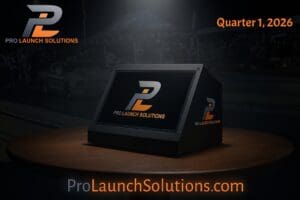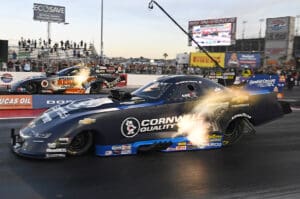Originally published January 2020

Thus was born the first of the Pro Stock J-cars, the Yuill Brothers’ Pontiac J-2000.
The J-2000 headlined Pontiac’s J-bodied lineup and was a successor to the rear-wheel-drive Sunbird. It was one of the first front-wheel-drive offerings, following the Pontiac Phoenix, and offered either a four-cylinder 1.8 or 2.0-liter engine.
While it was no high-performance musclecar on the street, the Yuill Brothers, Mark and Brad, saw the car with aerodynamic eyesight. In other words, the car looked like it would be really fast with a newly-mandated 500-inch engine.
When all was said and done, the Yuill Brothers delivered a car that looked every bit of the future of Pro Stock. The NHRA apparently didn’t subscribe to the foresight of the brothers who reside from Reno, Nevada.
“That’s when the NHRA introduced the new Yuill rules,” Mark Yuill recalled. “Yeah, no more of that [after one season].”
In an era when NHRA’s staple rule of Pro Stock outside of the understood law of no nitrous was the requirement of steel roof and quarters, there was no mention of how the body was to be attached to the chassis.
The Yuill Brothers Pontiac had steel roof and quarters, alright. It’s just the Yuills interpretation that it could be a one-piece lift-off body that apparently didn’t sit well with the tech department.
“Well, there was nothing that said it couldn’t be,” Yuill said. “If it doesn’t say it can’t come off, then why not?”
Yuill said the one-piece body wasn’t a performance advantage as much as it was implemented to keep the car looking like a show car.
“We were able to garner a lot of glory with our stuff because of the fact our stuff was so clean,” Yuill explained. “I liked the idea of being able to take the body off the car not necessarily between round maintenance, because we didn’t do that very much, but was cleaning it between races, really being able to get to all of the frame rails and all the suspension pieces and everything else clean was just very, very cool.
“When you took all the tires and wheels off, and the body off and everything is in the shop, you could really clean that thing, and it’d be nice. It was that way all the time. Those cars build up a load of rubber, just in the fender welds, from doing all the burnouts and that. Just very hard to clean all that stuff. It’s a lot easier to clean it when you put that whole body way up in the air.”
And even if the car did present a performance advantage, Yuill said they wouldn’t have known.
“All the sixty-foot and incremental timing, and today’s modern measurables were pre-that car,” Yuill added.
 Long before the future J-Cars such as the Firenzas hit the strip, there was the Yuills’ J-2000.
Long before the future J-Cars such as the Firenzas hit the strip, there was the Yuills’ J-2000.
“The J car that we had was really the first of its kind,” Yuill explained. “It was innovative in many ways, in many ways. A lot of initial thoughts and everything that went into it didn’t work too good. We had to change it.”
It didn’t take them long to notice when the car got on the top-end; those so-called aerodynamics made the J-2000 develop a mind of its own in the second half of the quarter-mile.
“It had its moments, that’s for sure, but it would get up on the rear tire and just start skating the tire like a Funny Car,” Yuill explained. “The air would come back over the backend of the car and just lift the backend off the ground. It would just start baking the tires. At 1,000 feet on, it was just skating all over the place.
Try as they might, the Yuills couldn’t tame the beast.
“Even trying different types of spoiler applications that NHRA would allow us to get away with at that time, It still wasn’t right. We didn’t have the luxury like Warren [Johnson, who fielded a Firenza in 1986) did of putting those cars in the wind tunnel and all that.”
One season proved enough for the Yuills and their radical Pontiac. However, it’s not like they didn’t try to right the wrongs.
“I do feel that as many trips as we made down the old 1320 if one of our pro cars was ever going to hurt us, we never wrecked any of them, but if one of them was ever going to hurt us or kill us, it would have been that car,” Yuill admitted. “It just became a scary proposition every time you ran it because you really didn’t know what was going to happen when it came into the lights.
“At Gainesville, in the first round, I had put a big holeshot on Frank Iaconio. I was leading him coming into the lights when the car was at a 45-degree angle, and there wasn’t anything you were going to do with it. You were either going to stay in it and try to win the race, or you’re going to lift and save your ass, save the car. I don’t really know what happened, but I was glad that Frankie got by me.”
One had to wonder why the J-car worked so superbly for Johnson, and not Yuill. Yuill admitted a conversation with Johnson made it crystal clear.
“Well, you guys just didn’t do to your car what I did to mine,” Yuill said Johnson told him. “Warren had really changed that car up.”
If you really like the mountain motor Pro Stocks, we’ve dipped down in our archives for a multi-segment history lesson on how the large displacement factory hot rods started. – #ClassicDragRacing #DragRacingNews – https://t.co/FOJwA9yIVx pic.twitter.com/z42VdwD4Yb
— Competition Plus (@competitionplus) December 22, 2019

“We ran it all over the country. It was a big hit, was a big hit on the match race, and we spent a lot of time back there on the east coast with Moroso [now Palm Beach International], Budds Creek, and Suffolk. My brother and I really were pretty young at that time, and the stalwarts of the competition like Grumpy Jenkins and Ronnie Sox could draw the big match race money. We’d get a decent buck for the match race, and that’s what kept us out on there racing.”
The response from the fans was almost as entertaining as driving the car, Yuill admits.
“We took the body off in the pits, and this one guy goes, ‘S***, that’s an itty bitty Funny Car,” Yuill remembered. “Another guy says, “I told you they run Pontiac motors. You knew they were running Pontiacs.”
“Of course, it’s a big, block Chevrolet.”
The J-2000 was a significant change from their 1981 Camaro, which finished eighth in the NHRA points back in the pounds-per-cubic inch days.
“Our car was always from A to B,” Yuill said. “It was straight and drivable and everything like that. Well, that wasn’t the case with the J car. That thing was anything but straight and drivable.
“We could, with our previous car on the match race circuit or most of those tracks on the east coast, west coast, lesser tracks, lesser than national event type competition. Our car would always go down the track. We beat a lot of people by not having the fastest car but having the best car. We could set it up to run on grease and butter if we had to.”
Failing to qualify at the 1982 NHRA U.S. Nationals was the final straw for Yuill, who realized something had to change.
“It qualified 17th at Indy, which was nauseating to me,” Yuill admitted. “It just made my stomach sick because we were the fastest care, mile per hour because it would free up and really run going towards the lights. We had worked with it a little bit, so it was a little bit better. It just never was quite right.”
Yuill sent the car to chassis builder Willie Rells, who back-halfed the chassis. They took the reworked car to the WCS event at the old track in Las Vegas, and with the same engine which was in the car at Indy, with Brad driving, ran in the sevens. The J-2000 went on to win the Pro Stock portion of the event, which immediately drew cries of foul following the Indianapolis DNQ.
“There’s one thing for sure, the Yuill Brothers never cheated at anything, and it was kind of like a fistfight almost, not really bad, but pretty bad down at the other end of the track,” Yuill said.
The brothers also reached the semi-finals at the next NHRA national event in Freemont.
The Yuills sold the car at the end of the season to Ted Gord and Mike Ferderer, who went on to win an NHRA Super Gas championship.
“When you take a second and a half out of it, take that kind of power out of it, the car would hook up really good,” Yuill said. “If we’d have known what we knew, later on, we could have changed a few things and been a lot better conceptually. But it was what it was, did good, won some match races with it, beat some big guys back there.
“It never hurt us. We never crashed it. We sold it, had a good time. Got a lot of ink, a lot of good publicity out of it. That’s what the J car was all about.”
Yesterday, in our visit back to the archives, we told the story of the pounds-per-cubic inch era for NHRA Pro Stock. Today, we delve a bit deeper with a look back at the early days of 500-inch Pro Stock. #ClassicDragRacing #dragracingnews – https://t.co/Y4rOIvObgk pic.twitter.com/Sr4NomfzVe
— Competition Plus (@competitionplus) December 19, 2019









































